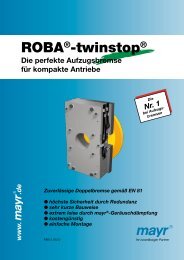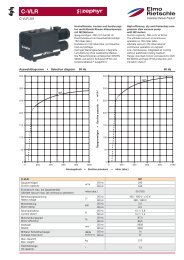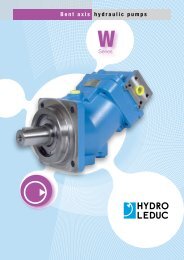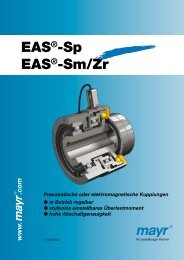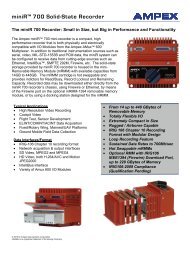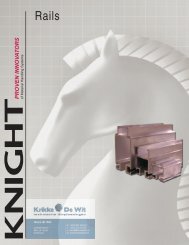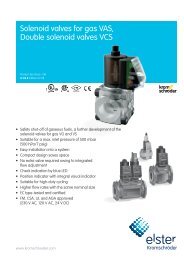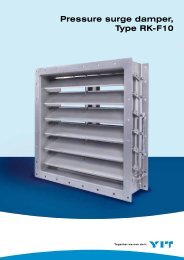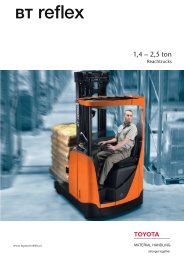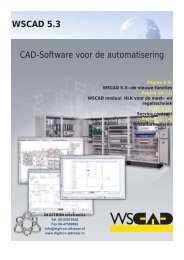CENTAX®-SEC - Industrial and Bearing Supplies
CENTAX®-SEC - Industrial and Bearing Supplies
CENTAX®-SEC - Industrial and Bearing Supplies
Sie wollen auch ein ePaper? Erhöhen Sie die Reichweite Ihrer Titel.
YUMPU macht aus Druck-PDFs automatisch weboptimierte ePaper, die Google liebt.
5. Allowable continuous vibratory torque (acvt)<br />
The allowable continuous vibratory torque is the amplitude<br />
of the continuously allowable periodic torque<br />
fluctuation with a basic load up to the value T KN up to<br />
a frequency of 10 Hz, <strong>and</strong> a maximum ambient temperature<br />
of 30°C.<br />
The value for the allowable continuous vibratory torque<br />
is a value for the mechanical strength of the rubber<br />
element. This value is of course limited <strong>and</strong>, where<br />
relevant, reduced by the ambient temperature <strong>and</strong> the<br />
effective frequency of the vibratory torque.<br />
These influences are nowadays taken into consideration<br />
in the calculation of the allowable power loss (section<br />
8) <strong>and</strong> do not have to be taken into account in<br />
this case.<br />
6. Dynamic torsional stiffness<br />
The dynamic torsional stiffness is the relationship<br />
of the torque to the torsional angle under dynamic<br />
loads.<br />
The torsional stiffness is constant in CENTAX couplings,<br />
i.e. the characteristics is straight or linear, it does not<br />
change with the torque.<br />
Due to the physical properties of the material rubber,<br />
the dynamic torsional stiffness of a coupling is widely<br />
depending on the following influences:<br />
a) Temperature<br />
Higher temperature reduces the dynamic torsional<br />
stiffness<br />
b) Frequency of vibration<br />
Higher frequencies increase the dynamic torsional<br />
stiffness. That means, that the dynamic torsional<br />
stiffness is higher than the static stiffness.<br />
Typically: C Tdyn<br />
≈ 1,3 C stat.<br />
c) Amplitude of vibratory torque<br />
Higher amplitudes reduce the dynamic torsional<br />
stiffness, therefore small amplitudes result in higher<br />
dynamic stiffness.<br />
For CENTAX couplings, the torsional stiffness is measured<br />
on our own test rigs <strong>and</strong> specified with the following<br />
marginal conditions:<br />
preload:<br />
0,5 ∙ T KN<br />
vibratory torque: ± 0,25 ∙ T KN<br />
frequency:<br />
10 Hz<br />
ambient temperature: t u<br />
= 20°C<br />
Tolerances in the rubber quality can mean that the dynamic<br />
torsional stiffness will deviate by ± 15% from<br />
the catalog value.<br />
In an ambient temperature of more than 30°C, the<br />
torsional stiffness will decrease.<br />
5. Zulässiges Dauerwechseldrehmoment<br />
Das zulässige Dauerwechseldrehmoment ist die Amplitude<br />
der dauernd zulässigen, periodischen Drehmomentschwankungen<br />
bei einer Grundlast bis zum Wert<br />
T KN , bis zu einer Frequenz von 10 Hz, und bis zu einer<br />
Umgebungstemperatur von 30°C.<br />
Der Wert für das zulässige Dauerwechseldrehmoment<br />
ist ein Wert für die mechanische Belastbarkeit des<br />
Gummielementes. Dieser Wert wird natürlich durch die<br />
Umgebungstemperatur und die effektive Frequenz des<br />
Wechseldrehmomentes begrenzt und gegebenenfalls<br />
reduziert.<br />
Diese Einflüsse werden heutzutage bei der Berechnung<br />
der zulässigen Verlustleistung (Abschnitt 8) berücksichtigt.<br />
6. Dynamische Drehsteifigkeit<br />
Die dynamische Drehsteifigkeit ist das Verhältnis von<br />
Drehmoment zu Drehwinkel bei dynamischer Belastung.<br />
Bei den CENTAX-Kupplungen ist die Drehsteifigkeit<br />
konstant, d.h. die Kennlinie ist gerade bzw. linear, sie<br />
verändert sich nicht mit dem Drehmoment.<br />
Durch die physikalischen Eigenschaften des Werkstoffes<br />
Gummi, ist die dynamische Drehsteifigkeit einer<br />
Kupplung u.a. von folgenden Einflüssen abhängig:<br />
a) Temperatur<br />
Höhere Temperatur reduziert die Drehsteifigkeit<br />
b) Frequenz der Schwingungen<br />
Höhere Frequenz steigert die Drehsteifigkeit. Das<br />
bedeutet, daß die dynamische Drehsteifigkeit höher<br />
ist als die statische Drehsteifigkeit. Erfahrungswert:<br />
C Tdyn<br />
≈ 1,3 C stat.<br />
c) Amplitude des Wechselmomentes<br />
Höhere Amplituden reduzieren die Drehsteifigkeit,<br />
geringe Amplituten ergeben daher eine höhere<br />
Drehsteifigkeit.<br />
Für die CENTAX-Kupplungen wird die Drehsteifigkeit<br />
auf unseren eigenen Prüfständen gemessen und mit<br />
folgenden R<strong>and</strong>bedingungen festgelegt:<br />
Vorlast:<br />
0,5 ∙ T KN<br />
Wechseldrehmoment: ± 0,25 ∙ T KN<br />
Frequenz:<br />
10 Hz<br />
Umgebungstemperatur: t u<br />
= 20°C<br />
Durch Toleranzen in der Gummiqualität kann die dynamische<br />
Drehsteifigkeit ± 15% von dem Katalogwert<br />
abweichen.<br />
Bei Umgebungstemperaturen über 30°C nimmt die<br />
Drehsteifigkeit ab.<br />
The following then applies:<br />
C Tdyn red<br />
= C Tdyn<br />
∙ S t3<br />
Es gilt:<br />
C Tdyn red<br />
= C Tdyn<br />
∙ S t3<br />
CX-<strong>SEC</strong>-app-2<br />
CATALOG CX-<strong>SEC</strong>-07-10



